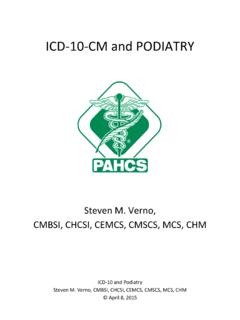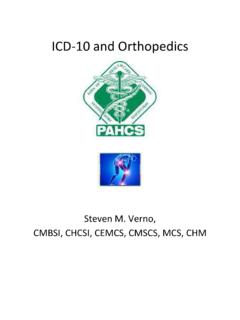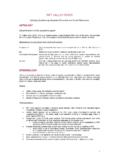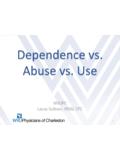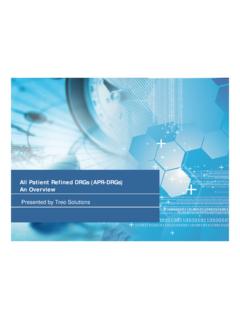Transcription of ICD-10 OVERVIEW FOR OB-GYN
1 ICD-10 OVERVIEW coding Guidelines For OB/GYN ICD-10 Chapter 15 Pregnancy, Childbirth and the Puerperium (O00-O9A) Note: Codes from this chapter are for use only on maternal records, NEVER on newborn records. Codes from this chapter are for use for conditions, related to or aggravated by the pregnancy, childbirth, or the puerperium (maternal causes or obstetric causes). The following are some of the changes and diagnoses that need documenting or that are different from or not found in ICD-9. Trimesters are counted from the first day of the last menstrual period. They are defined as follows: 1st Trimester - Less than 14 weeks, 0 days 2nd Trimester 14 weeks, 0 days to less than 28 weeks, 0 days 3rd Trimester 28 weeks, 0 days, until delivery Use additional code from category Z3A, weeks of gestation, to identify the specific week of the pregnancy.
2 Excludes 1 supervision of normal pregnancy ( ) Excludes 2 mental and behavioral disorders associated with the puerperium (F53), obstetrical tetanus (A34), postpartum necrosis of pituitary gland ( ) and puerperal ostomalacia ( ). Guidelines General Rules for Obstetric Cases Chapter 15 codes used ONLY on the maternal record 5th digit of ICD-9 is called final character for trimester in ICD-10 o 5th digits for each code are selection of trimester for inpatient admissions that encompass more than one trimester o Unspecified trimester o 7th character for fetus identification Selection of OB principal or first-listed diagosis: o Routine outpatient prenatal visits o Prenatal outpatient visits for high-risk patients o Episodes when no delivery occurs o When a delivery occurs o Outcome of delivery Pre-existing conditions vs conditions due to the pregnancy o Pre-existing hypertension in pregnancy o Fetal conditions affecting the management of the mother use codes O35 and O36 In utero surgery o Dibetes Mellitus in pregnancy Long-term use of insulin Gestational (pregnancy induced) diabetes o Sepsis and septic shock complicating abortion, pregnancy, childbirth and the puerperium o Puerperal sepsis o Poisoning, toxic effects, adverse effects and under dosing in a pregnant patient.
3 O Alcohol and tobacco use during pregnancy, childbirth, and the puerperium Alcohol use during pregnancy, childbirth, and the puerperium Tobacco use during pregnancy, childbirth, and the puerperium Normal delivery 650 is now Encounter for full-term uncomplicated delivery O80 Normal delivery with resolved antepartum complication is now Uncomplicated delivery with resolved antepartum complication single liveborn, out of delivery is now Outcome of delivery for O80 The peripartum and postpartum periods Postpartum complication now Peripartum and postpartum complication Pregnancy-related complications after 6-week period Admission for routine postpartum care following delivery outside of hospital Pregnancy associated cardiomyopathy Code 677 Late effect of complication of pregnancy now Sequalae of complication of pregnancy, childbirth and the puerperium O94 After the initial postpartum period Sequencing of code 677 now Sequencing of code O94 Abortions Abortion with liveborn fetus Retained products of conception following an abortion Abuse in a pregnant patient Diseases of Genitourinary System pertaining to OB/Gyn are found in N00-N99 but Excludes.
4 Certain conditions originating in the perinatal period (P04-O96) certain infectious and parasitic diseases (A00-B99) Complications of pregnancy, childbirth, and the puerperium (O00-O99) Endocrine, nutritional, and metabolic diseases (E00-E-90) Congenital malformations, deformations & chromosomal abnormalities (Q00-Q99) Injury, poisoning and certain other consequences of external cause (S00-T98) Neoplasms (C00-D48) Symptoms, signs & abnormal clinical & laboratory findings NEC (R00-R94) Pregnancy, Childbirth, Puerperium, Conditions Originating in the Perinatal Period, and Congenital Malformations Chapter 15 includes codes for obstetric (OB) patients. All procedures resulting from conditions located in Chapter 15 are indicated with a procedure code. The first OB code assigned should be based on the reason for the patient encounter.
5 The first assigned diagnosis should be the reason for the encounter. For patient encounters where no delivery occurs, the most significant complication of pregnancy should be sequenced first, if more than one complication occurs. When delivery occurs, the principal/first listed diagnosis should correspond to the main complication or circumstance of delivery. When Cesarean delivery occurs, the principal/first listed diagnosis should correspond to the reason the Cesarean delivery was performed unless the reason is unrelated to the condition resulting in the Cesarean delivery. The majority of the codes beginning with category O09 identify a final character indicating the trimester of pregnancy. Timeframe of trimester is provided at the beginning of this chapter. Trimesters are counted from the first day of the last menstrual period.
6 Trimesters are defined as follows: 1st trimester -- less than 14 weeks, 0 days. 2nd trimester -- 14 weeks, 0 days, to less than 28 weeks, 0 days. Codes for unspecified trimester should never be reported unless it is impossible to determine the trimester from the medical record documentation in the medical record. The provider s documentation in the medical record based on the number of weeks documented should be used in assigning the appropriate trimester of the pregnancy. Review the Official ICD-10 -CM Guidelines for coding and Reporting in Chapter 15. General Rules for Obstetric Cases. Pregnancy incidental: Obstetric cases require codes from Chapter 15, Pregnancy, Childbirth, and the Puerperium (code range (O00-O9a). Should the physician document that the pregnancy is incidental to the encounter, then code (pregnancy, incidental state) should be used in place of any Chapter 15 codes.)
7 The physician should document in the medical record that the condition being treated is not affecting the pregnancy. Normal pregnancy: Normal pregnancy is coded in Chapter 21 (Factors Influencing Health Status and Contact with Health Services) category Z34, encounter for supervision of normal pregnancy. A code from this category is selected for routine OB care based on trimester and whether the patient s pregnancy is the first or subsequent pregnancy. Pregnancy with abortive outcome: An ectopic pregnancy is any pregnancy arising from implantation of the ovum outside the cavity of the uterus. About 98% of ectopic pregnancies are tubal. Other sites of ectopic implantation are the peritoneum or abdominal viscera, the ovary, and the cervix. Peritonitis, salpingitis, abdominal surgery, and pelvic tumors may predispose to abnormally situated pregnancy.
8 Symptoms include amenorrhea; tenderness, soreness, and pain on the affected side; and pallor, weak pulse, and signs of shock or hemorrhage. Hydatidiform mole is a rare condition that is similar to an abortion, except that the placenta undergoes degenerative cystic, edematous changes that make it resemble a bunch of grapes. It is thought to be caused by abnormal postfertilization replication of spermatozoal chromosomes. Ectopic and abnormal products of conception are classified from O00-O08, which include the following subclassifications: Hydatidiform mole O01- Other abnormal products of conception O02- Spontaneous abortion O03 Complications following (induced) termination of pregnancy O04 Failed attempted termination of pregnancy O07 Complications following ectopic and molar pregnancy O08 Abortion: An abortion is the interruption or termination of pregnancy before the fetus is considered viable.
9 The different types of abortion include: Spontaneous abortion: also called miscarriage; abortion occurring without apparent cause. Complete: an abortion in which the complete products of conception have been expelled. Incomplete: an abortion in which part of the products of conception has been retained in the uterus. Missed: an abortion in which the fetus has died before completion of the 20th week of gestation, but the products of conception are retained in the uterus for 8 weeks or longer. Elective abortion: voluntary termination of a pregnancy for other than medical reasons. Therapeutic abortion: abortion performed when the pregnancy endangers the mother s mental or physical health or when the fetus has a known condition incompatible with life. Abortion: The ICD-10 -CM guidelines direct the user to select a code from category O03, or O07 for subsequent encounters for retained products of conception following a spontaneous abortion.
10 If the patient attempts to terminate the pregnancy and it results in a liveborn fetus, a code from category is assigned. A code from category Z37 is assigned for a patient with preterm labor and delivery. A failed attempt to terminate the pregnancy is coded as (elective termination of pregnancy) if there are no complications. Supervision of high-risk pregnancy (O09): Codes in this category are to be used for prenatal care for patients with high-risk pregnancies An example of a patient at high risk is one who is under sixteen years of age. If a trimester character is not provided for a specific code in the category, it is because the condition always occurs in a specific trimester, or the trimester is not applicable, such as postpartum care. Complications mainly related to pregnancy O10-O29: This section includes the following conditions: Hemorrhage in early pregnancy.


